Shelves are a smart way to display and store helpful items in a visually pleasing way. However, you may question how much space there should be between shelves.
To help, we researched expert suggestions about placing shelves, including bookshelves, in various rooms.
You are watching: How Much Space Should Be Between Shelves?
Learn how the distance between shelving can improve the look of a room and impact how you interact with your possessions.
Most open or floating shelves in the living room, kitchen, or bedroom have a distance of 8 to 12 inches between each. However, a gap of 7 to 15 inches between shelves is permissible.
For bookcases, shelves are usually 8 to 12 inches from one another. Overall, maintaining a space of 12 inches between shelves is the sweet spot.
Continue reading to learn more about appropriately spacing shelves for aesthetics and access to open storage.
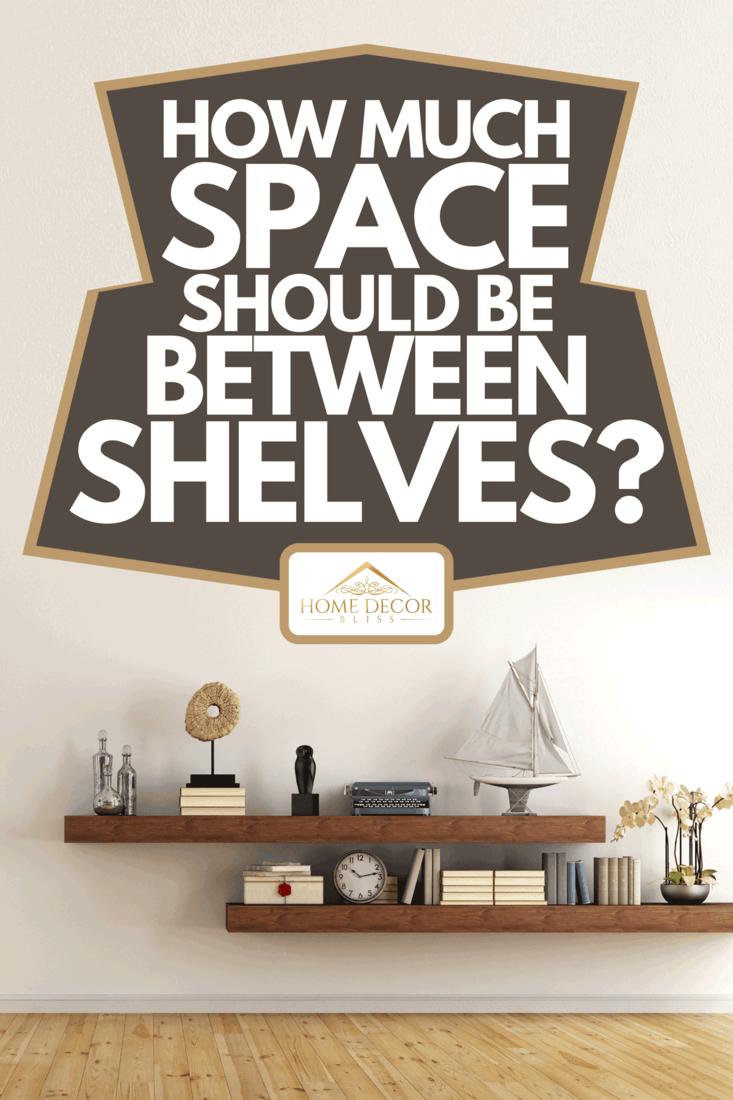
The Optimal Shelving Space
Using shelves for keeping books, spices, art, plants, and other items is a handy open storage solution. However, it is important to consider how much space is needed to access anything on shelves easily.
There is nothing more frustrating than struggling to place items on a shelf or remove them because there isn’t enough space between shelves.
Depending on the room your shelves are in, a dedicated purpose for practical or aesthetic use, and if the shelves are part of furnishing should help you decide on the proper amount of space needed between planks.
The allure of open shelving has yet to wane fully. People love how open shelving makes a space appear lighter, roomier, and less constricted. Of course, when using open shelving, you need to be careful about how items are arranged and avoid a cluttered, messy shelf.
Additionally, it is a good practice to consider how items will visually interact with the space, relate to one another, and physically weigh down a shelf. Look for shelves with enough width and depth to suit your needs.
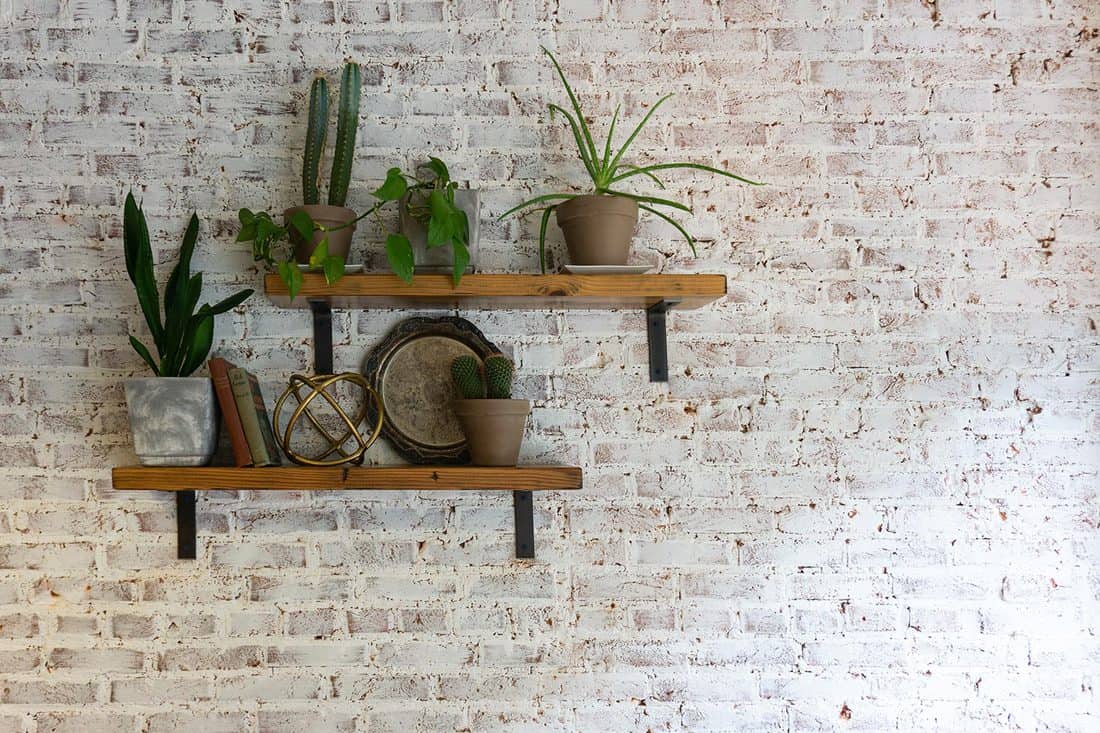
Points To Consider
Open shelving looks good in offices, bathrooms, hallways, kitchens, bedrooms, living rooms, and foyers. Don’t miss out on the benefits of using shelves in homes where space is limited and at a premium.
Use shelves to show off personal effects, add visual interest, and let the light in. Compared to traditional cabinets and other storage, open shelving draws the eye vertically and doesn’t block as much light.
Do keep in mind the following dimensions for best results with your shelving, depending on its location:
Kitchen
Usually, the topmost shelf is the shallowest for easy access to items. Be careful with shelves that are so deep that items get pushed far back.
Kitchen shelves usually have a depth of 16 to 20 inches for a pantry, but you can work with a depth of 12 inches. Look for shelves that are 17 inches to 21 inches wide.
Bathroom
Read more : Tips for Prepping Kitchen Cabinets for Painting
Choose shelves with a depth of 14 inches and go wider than 12 inches if possible. Opt for a width of 19 to 24 inches for ample room for towels, soaps, and other bath items if space permits.
Office
Play around with shelves to meet the needs of your office space around the desk. Typically, shelves with a depth of 12 inches and a width of 14 to 16 inches should suffice.
Living Room
For shelves that are 3/4 to 1-inch thick, consider widths of 30 to 36 inches. Keep in mind shelves can have a depth as small as 6 inches and up to 24 inches to fit your space.
Shelving can be floating, have visible support brackets, and be made from wood, metal, or other durable materials. Make sure shelves are level and do a stress test before fully committing to any items placed on a shelf.
Should Shelves Be Evenly Spaced?
You may want to space shelves evenly toward the bottom of a shelving set and tighten the gap at the top. The space between shelves is a matter of personal preference and as the space dictates.
Make sure to space shelves so the display doesn’t appear top-heavy and visually stressed on the topmost shelf.
You can trick the eye by staggering shelves and arranging them on a diagonal or spread out horizontally rather than rely on a vertical placement. Ideally, most shelves work well having a distance of 8 to 15 inches between each shelf.
Of course, adjust the distance between shelves as needed to house your items.
What Is The Best Height For Shelves?
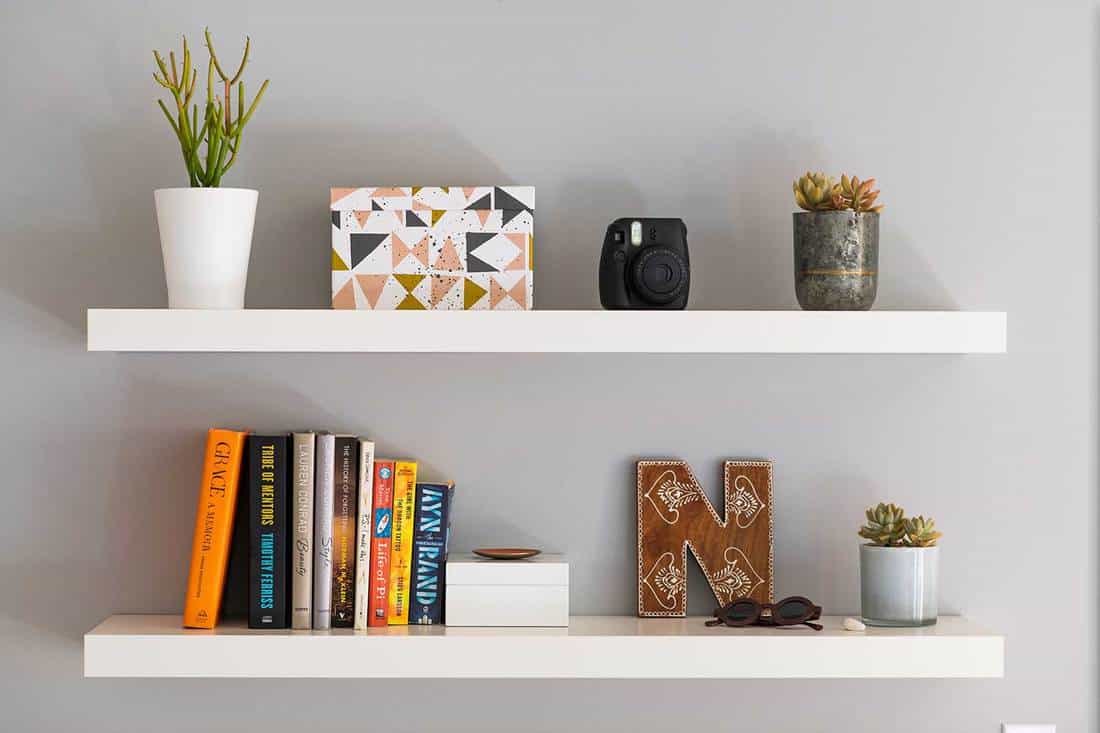
When hanging shelves, you have to keep in mind their function and location. Most people want a shelf to hang so it is near eye-level, with a height of 4 to 5 feet from the floor. Check out the following for reference before placing shelves.
- Office Space – Set a shelf a minimum height of 22 to 24 inches above a desk
- Bathroom – Shelves set above the toilet should be at least 2 feet above the tank
- Hallway – Opt for a height of 5 to 6 feet off of the floor
- Living/Dining Room Wall – A height of 4 to 4 1/2 feet is sufficient
- Behind Couch – Keep a minimum distance of 10 inches above the back of a couch
Before installing a shelf, make sure to use a measuring tape and level for best results. Feel free to enlist the help of a friend to make sure levels are securely fastened to their location and level.

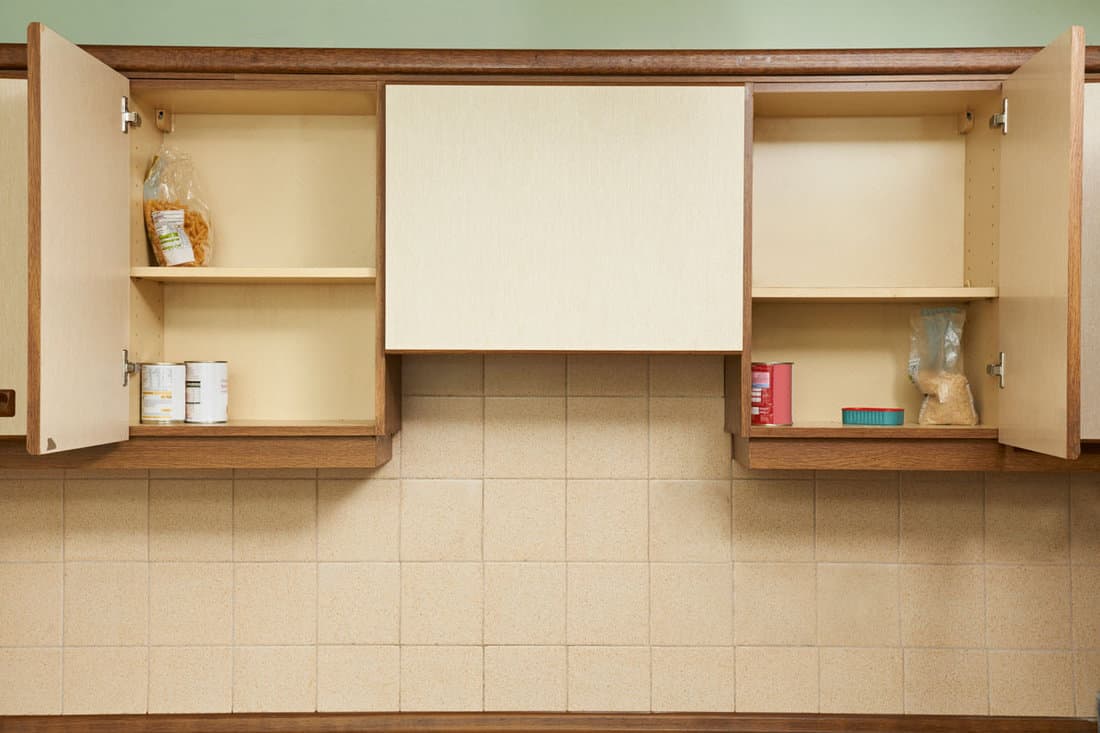
Check out this level with an included laser on Amazon.
What Is A Good Shelf Depth?
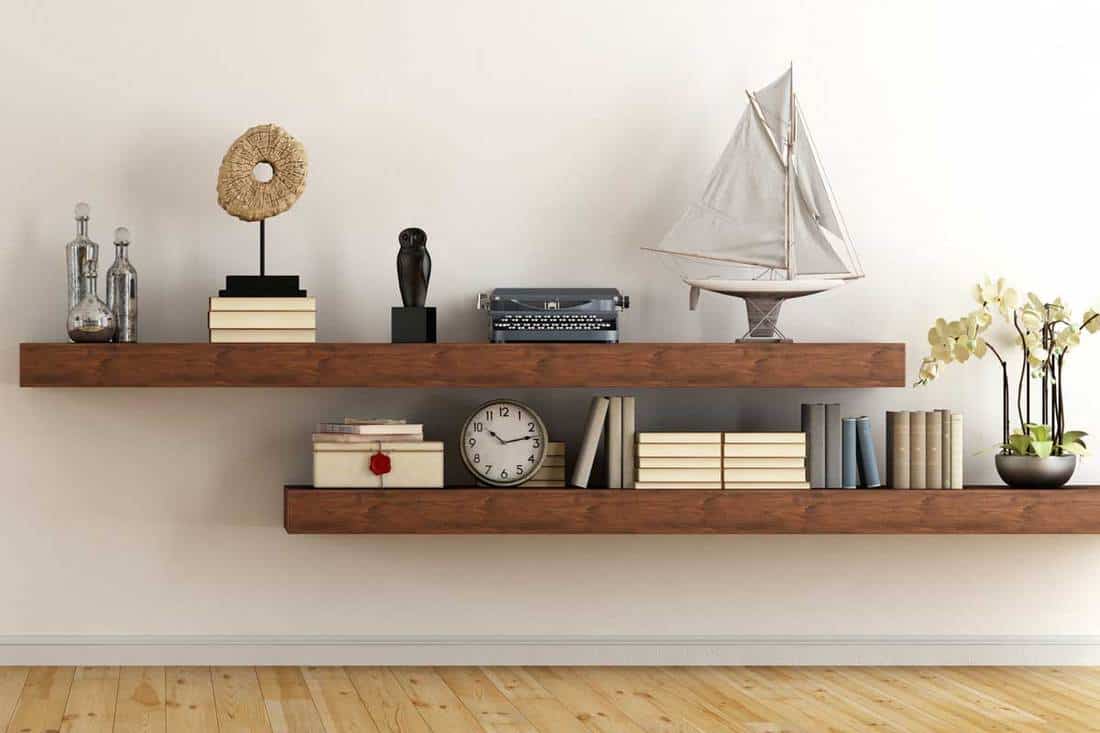
When selecting open shelves, you want a depth of 10 to 12 inches for enough support for items, no matter the length of the shelf. You want a depth of at least 10 to 12 inches, especially for bathrooms and kitchens, to increase stability and security.
You don’t want to risk a shelf dropping or dipping in the middle, struggling to hold up items because of a short depth.
Most bookshelves have a depth of 10 to 12 inches, and many standard types of furniture with shelving have a shelf depth of 16 to 20 inches.
Keep in mind how you will use a shelf or shelving before deciding on an appropriate depth. Realize that shelving with a higher depth allows for easier access to items without fear of an accident or instability.
How Thick Should Open Shelves Be?
Read more : How Many Outlets on a 20 amp Circuit?
Look for shelves in a thickness of 2 to 2 1/4 inches up to 3 1/2 or 4 1/2 inches. Depending on the thickness of the open shelving, you should pick an appropriate support bracket to match.
If you are using cut lumber to create open shelves, each shelf should be 1-inch thick at the minimum and include heavy-duty support brackets.
Is Open Shelving Going Out Of Style?
If you were worried that open shelving is passe, it’s not. Using open shelving in a kitchen or other rooms makes a space feel roomier and allows more light to flood a space.
The beauty of open shelving forces you to think critically about how you display items and reduce clutter. Open shelving fits a variety of aesthetic treatments for a room, including minimalism, rustic farmhouse, eclectic, and even industrial.
Check out this floating shelf set on Amazon.
How Far Can A Shelf Span Without Support?
A shelf will require minimum support, no matter if it is plywood, wood, particleboard, or glass. Expect different materials to have a range of 18 to 60 inches before needing additional support.
A good rule to follow is two supports are needed at opposing ends of a shelf. Longer shelves or shelves that will bear heavy loads should have at least 3 or 4 supports.
he center and sides of a shelf will need ample support if it is nearing 72 inches or longer or would suffer instability and buckle.
Check out these shelf supports on Amazon.
In Closing
We hope you know the amount of space between shelves has so much impact visually and for practicality sake. Shelves are an excellent way to organize and display useful items for the bathroom or kitchen or store things high up when space is limited.
Use the space between shelving to create interest, eye movement on a wall, and accent a room. Stick to a space of 7 to 15 inches between shelves for the best results, depending on the dimension of your room and lifestyle needs.
Use your best judgement, and make sure shelves are level and properly supported to prevent accidents.
Before you go, don’t miss out on the following helpful articles.
Read More: 22 Great Wall Shelving Ideas
Read More: How To Arrange Plants On A Shelf [A Complete Guide]
FAQs
How far should shelving be set?
The distance between shelves should be based on the size and type of items stored on them. Generally, shelves should be placed between 12 and 18 inches apart for most items, although there may be some variation depending on the items.
What are the OSHA requirements for shelves?
The Occupational Safety and Health Administration (OSHA) does not have specific requirements for shelves, but general safety guidelines for storing materials should be followed. Shelves should be constructed and maintained to prevent materials from falling and sturdy enough to support the weight of the materials placed on them. If the shelves are in a hazardous area, they should be secured to the wall or other structure. In addition, the edges of shelves should be protected with guards to prevent objects from rolling off.
Source: https://gardencourte.com
Categories: Kitchens

